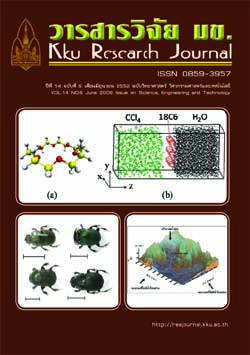Effect of bubble size and salinity on efficiency of total solids separation of foam fractionation in aquaculture (Thai)
Main Article Content
Abstract
The first experimental purpose of this work was to study the effect of bubble size and salinity on total solid separated efficiency of a foam fractionator. Completely randomized factorial design was used. Four bubble sizes, 0.57, 2.14, 3.65 and 7.82 mm and 4-water salinity levels, 0, 10, 20 and 30 ppt were applied. Results of the study show that the best bubble size and salinity for total solid separation were 2.14 mm and 30 ppt, respectively.
The results from the first experiment were applied to the second experiment in artemia culture tanks. The experimental treatment was compared between artemia culture units with and without a foam fractionator. Results illustrate that foam fractionator could decrease 22.16% of total solid, 19.15% ammonia, 16.19% nitrite, 16.75% nitrate, 19.09% total inorganic nitrogen and 14.37% orthophosphate and increase by 66.45% the survival rate, by 30.26% the length of the nauplius and by 5.07% the length of the artemia. The consequences of this study can be used for water treatment in other aquacultural activities.


